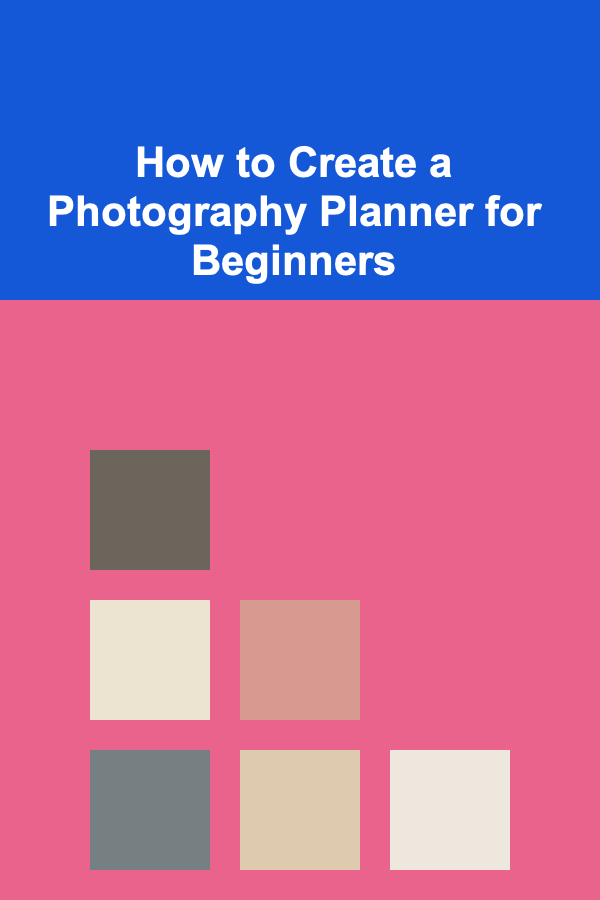
How to Create a Photography Planner for Beginners
ebook include PDF & Audio bundle (Micro Guide)
$12.99$9.99
Limited Time Offer! Order within the next:

Photography is an exciting and creative skill, but like any artistic endeavor, it requires organization and planning to develop fully. Whether you're a beginner just starting to learn the ropes or someone trying to refine your skills, a photography planner can help you stay organized, track your progress, and make the most of your photographic journey.
Creating a photography planner doesn't have to be complex; it's about setting clear goals, creating a structured plan, and keeping track of your growth as you develop your skills. In this article, we will walk through how to create a photography planner for beginners. We'll cover everything from goal-setting and essential photography skills to shooting schedules and self-reflection techniques.
Start with Clear Goals
The first step in creating a photography planner is setting clear goals. Without a goal in mind, it's easy to get lost or overwhelmed, especially when starting out. Your goals should be specific, measurable, and realistic. Having clear goals will help guide your learning path and provide a framework for your practice sessions.
Types of Photography Goals
There are several types of goals you may want to consider when creating your planner:
- Skill Development Goals: For example, you may want to master manual mode on your camera, improve your composition, or learn a specific photography technique such as portrait photography, landscape photography, or macro photography.
- Project-Based Goals: You might want to complete a specific project, such as capturing a series of street portraits, creating a photo essay, or documenting an event like a wedding or family gathering.
- Creative Goals: This could involve experimenting with a new photography style or trying different editing techniques. You may want to work on developing your signature style or capturing photographs with a certain mood or theme in mind.
- Portfolio Building Goals: If you are working towards a professional photography career or just want to track your progress, building a portfolio could be a crucial goal. This involves choosing your best shots, curating a cohesive collection, and refining the presentation of your work.
Setting SMART Goals
To make sure your goals are effective, try using the SMART goal-setting method, which stands for Specific, Measurable, Achievable, Relevant, and Time-bound. For example:
- Specific: I want to learn how to use manual mode on my camera.
- Measurable: I will take 50 photos in manual mode by the end of the month.
- Achievable: I will practice for 30 minutes each day to master manual settings.
- Relevant: Learning manual mode is essential for advancing my photography skills.
- Time-bound: I will master manual mode in two weeks.
Setting SMART goals will provide clarity and make it easier to track your progress.
Break Down Photography Skills
Photography is a multifaceted skill, and as a beginner, you will need to break it down into digestible chunks. In your planner, create a list of essential skills and techniques to focus on. This breakdown will help you stay organized and ensure you don't miss out on key areas of development.
Camera Settings and Techniques
Begin by familiarizing yourself with your camera settings and the fundamentals of exposure. These include:
- Aperture: Understanding how the aperture controls the depth of field and the amount of light entering the camera.
- Shutter Speed: Learning how shutter speed impacts motion blur and exposure.
- ISO: Grasping how ISO settings affect image noise and sensitivity to light.
- White Balance: Getting to know how different light sources affect the color temperature of your photos.
You can set goals to practice these concepts by setting up practice sessions. For example:
- Week 1: Focus on mastering aperture and depth of field.
- Week 2: Practice adjusting shutter speed to capture motion or stillness.
Composition
Mastering composition is one of the most important aspects of photography. Here are a few key compositional techniques to work on:
- The Rule of Thirds: Dividing the frame into thirds both horizontally and vertically to place subjects at the intersection points.
- Leading Lines: Using natural or man-made lines to draw the viewer's eye toward the subject.
- Framing: Using elements in the environment (like windows or doorways) to frame your subject.
- Symmetry: Finding balanced and symmetrical scenes to create aesthetically pleasing photos.
Lighting
Understanding lighting can make or break a photo. Start by experimenting with different lighting scenarios, including:
- Natural Light: How to use sunlight during different times of the day (golden hour, midday, etc.).
- Artificial Light: Experimenting with indoor lighting setups like lamps, flash, or studio lights.
- Lighting Direction: Understanding how the direction of light affects shadows and highlights.
You might set weekly challenges to experiment with different light sources and their effects on your photos.
Editing Techniques
Editing plays a significant role in modern photography. Some skills to focus on include:
- Basic Editing: Learning how to adjust exposure, contrast, brightness, and saturation.
- Advanced Editing: Mastering techniques like retouching, cloning, and compositing.
- Presets and Filters: Experimenting with pre-made filters or creating your own for a consistent look.
As part of your photography planner, designate specific weeks to practice these techniques. For example, you might dedicate one week to color correction and another to black-and-white editing.
Create a Weekly Schedule
Now that you have a clearer idea of your goals and the skills you need to master, it's time to create a weekly schedule to structure your practice. A schedule will ensure that you stay consistent and organized in your learning process.
Determine Your Available Time
Start by evaluating how much time you can realistically dedicate to photography each week. Are you able to take photos every day, or do you need to plan for a few hours each week on weekends? Whatever your availability is, be sure to create a schedule that aligns with it.
Plan Photo Shoots
A key part of learning photography is applying your theoretical knowledge through practice. Schedule regular photo shoots where you can focus on specific skills. For example, you might decide to shoot landscapes every Sunday afternoon or dedicate Wednesday evening to practicing portrait photography.
Ensure you vary your locations and subject matter to keep things fresh. This will allow you to experiment with different settings, lighting, and compositions.
Review and Reflect
Set aside time each week to review your photos. This could involve:
- Assessing your progress: Are you improving in areas like exposure, focus, and composition?
- Identifying challenges: Where did you struggle? Is there a particular technique that you need to revisit?
- Making adjustments: If you noticed certain skills are lacking, adjust your schedule to focus on those areas.
This weekly reflection time is essential for growth, as it allows you to critically analyze your work and learn from both successes and failures.
Track Your Equipment and Settings
In your planner, create a section dedicated to tracking the equipment you use and the camera settings that work well for different situations. This will help you remember what works and what doesn't, especially as you experiment with different genres of photography.
- Camera Body and Lens: Note down the camera and lens you used for each shoot.
- Settings: Write down your aperture, shutter speed, and ISO for each shot. This is especially useful for tracking which settings produce the best results in various environments.
- Lighting Conditions: Make a note of the lighting conditions for each shoot, so you can replicate good results or avoid mistakes in future projects.
Tracking your settings will help you improve your understanding of how different variables affect your photos and fine-tune your shooting techniques.
Build Your Portfolio
A photography planner isn't just for learning; it's also a great way to track your progress and build your portfolio. As you complete photo shoots, choose your best work and organize it into categories. You might want to separate photos into collections based on:
- Portraits
- Landscapes
- Events
- Product Photography
Include a few examples of different types of photography to show off your versatility. Over time, you can revisit your portfolio, updating it with new work and removing older images as you progress.
Keep Learning and Seeking Inspiration
Your photography planner should also encourage continuous learning and exploration. Set goals to attend workshops, watch tutorials, read photography books, or follow inspirational photographers on social media. Learning from others will expose you to new techniques and creative ideas.
Regularly seek inspiration from photography websites, Instagram accounts, and photography magazines. This will keep you motivated and inspire new project ideas.
Reflect on Your Progress
At the end of each month or season, take time to reflect on your growth. What areas have you mastered? Which skills need more work? Reflecting on your progress allows you to set new goals and adjust your planner to better suit your evolving skills.
End-of-Month Reflection
- What did I learn this month?
- Which areas do I need to improve?
- How can I challenge myself next month?
Reflection helps you stay on track and provides a sense of accomplishment as you see how far you've come.
Creating a photography planner for beginners doesn't need to be a complex process. It's about finding structure in your learning, practicing consistently, and documenting your progress. With clear goals, a solid schedule, and the right mindset, you can take your photography skills to the next level and build a portfolio that truly reflects your growth.
Reading More From Our Other Websites
- [Organization Tip 101] How to Create a Backup Supply Station in Your Bathroom
- [Personal Care Tips 101] How to Choose the Best Conditioner for Winter Hair Care
- [Home Holiday Decoration 101] How to Use Rustic Elements for a Warm Holiday Home
- [Home Budget Decorating 101] How to Decorate Your Home with a Small Budget for Big Impact
- [Organization Tip 101] How to Create a Travel Packing Checklist for Organization
- [Mindful Eating Tip 101] From Fast Food to Food Freedom: Mark's Journey to Conscious Consumption
- [Home Pet Care 101] How to Pet-Proof Your Kitchen for Safety
- [Home Holiday Decoration 101] How to Create an Advent Calendar for Festive Countdown
- [Home Pet Care 101] How to Choose and Maintain Pet‑Friendly Flooring for a Happy Home
- [Home Security 101] How to Ensure Your Home Security Devices Are Always Functioning Properly

How to Incorporate Pet Safety into Your Home Organization
Read More
Saving Money on Home Meal Delivery Services: A Complete Guide
Read More
The Compliance Officer's Playbook: Best Practices for Ensuring Organizational Integrity
Read More
Turn Your Deep Learning Skills into Passive Income
Read More
10 Tips for Staying Fit on the Go: A Flight Attendant's Perspective
Read More
How to Build a Pallet Coffee Table
Read MoreOther Products

How to Incorporate Pet Safety into Your Home Organization
Read More
Saving Money on Home Meal Delivery Services: A Complete Guide
Read More
The Compliance Officer's Playbook: Best Practices for Ensuring Organizational Integrity
Read More
Turn Your Deep Learning Skills into Passive Income
Read More
10 Tips for Staying Fit on the Go: A Flight Attendant's Perspective
Read More